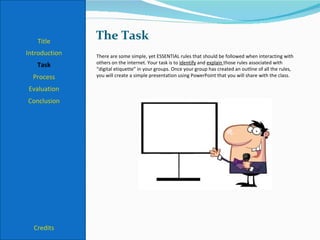Digital etiquette
- 1. Oops, Your Manners Are Showing! Title Introduction Task Process Evaluation Conclusion Credits A WebQuest for 9th Grade about Digital Citizenship Designed by Ms. Zapata-Van Nostran [email_address] Based on a template from The WebQuest Page
- 2. Introduction Title Introduction Task Process Evaluation Conclusion Credits Weâve all been there! Youâre sharing a meal with someone and you do something that causes them to stop and look at you like youâre from another planet. Having someone stop what they are doing to stare at you can be unnerving at best, but it might also cause you to wonder, âWhat do they all know that I donât?â In every social situation there are expectations and rules (sometimes implied or directly stated) that govern the way that our culture behaves. This is true for online social interactions as well; also known as âDigital Etiquetteâ or âNetiquetteâ. Throughout this Webquest, you will be exploring answers to the question: What is digital etiquette and how do I practice it during my online interactions?
- 3. The Task Introduction Task Process Evaluation Conclusion Credits There are some simple, yet ESSENTIAL rules that should be followed when interacting with others on the internet. Your task is to identify and explain those rules associated with âdigital etiquetteâ in your groups. Once your group has created an outline of all the rules, you will create a simple presentation using PowerPoint that you will share with the class. Title
- 4. The Process Title Introduction Task Process Evaluation Conclusion Credits First, go to: http://www.digitalcitizenship.net/Nine_Elements.html and read about all of the themes of digital citizenship. Pay special attention to #5. Next, go to: http://www.brainpop.com/technology/computersandinternet/digitaletiquette/ and watch the video clip about digital etiquette. Do not write anything yet, just watch it all the way through once. Now, re-watch it and write down 3 words that you can define and share with the class in your presentation. Re-watch it again and identify three or more ârulesâ related to communication that you can include in your presentation. Discuss within your group if there is anything that wasnât discussed in the clip that you think should be included in your presentation. Work together through Google Docs to create your presentation. Each group member must create and present at least one slide. (Put your name in the right corner at the bottom of your slide.) When it is your turn to present, turn in a print out of the slides included in your presentation (4 per page) and your outline/brainstorming notes.
- 5. Evaluation Title Introduction Task Process Evaluation Conclusion Credits Beginning 20 Developing 30 Accomplished 40 Exemplary 50 Score Brainstorming Process/Note Sheet Student did not turn in evidence of brainstorming or note taking. Student turned in note taking sheet that included less than 2 defined words and/or less than 2 rules related to digital etiquette. Student turned in note taking sheet that included 2 defined words and 2 or more rules related to digital etiquette. Student turned in note taking sheet that included 3 or more defined words and 3 or more rules related to digital etiquette. Presentation Student did not create a slide and/or did not present a slide. Student created 1 slide, but did not present it or vice-versa. Student created 1 slide and presented it during the presentation. Student created 2 or more slides and/or presented 2 or more slides.
- 6. Conclusion Title Introduction Task Process Evaluation Conclusion Credits CONGRATULATIONS! You have completed your Webquest on digital etiquette. It is up to the rest of the class to present the other 8 themes of digital citizenship. Each theme is important to keep in mind when using the internet. Below are some other links that you may be interested in if you would like to learn moreâĶ http://www.brainpop.com/technology/computersandinternet/digitaletiquette/quiz/ http://www.nisd.net/digitalcitizen/
- 7. Credits & References Title Introduction Task Process Evaluation Conclusion Credits Images: http://www.officeclipart.com/office_clipart_images/business_person_or_sales_person_with_microphone_giving_presentation_at_white_board_0521-1005-1515-3155.html http://www.blogher.com/tips-teaching-children-table-manners Websites: http://www.digitalcitizenship.net/Nine_Elements.html http://www.brainpop.com/technology/computersandinternet/digitaletiquette/quiz/ http://www.nisd.net/digitalcitizen/ http://www.brainpop.com/technology/computersandinternet/digitaletiquette/
- 8. TEACHER PAGE Title Introduction Task Process Evaluation Conclusion Credits Honestly, I have no idea what to put hereâĶ I imagine, I would put notes about things that I want to emphasize. -I think itâs important to remind students that they have a limited amount of time to work on this in the lab and as a group. If they donât utilize their time, they will not be given more time in class and will have to meet on their own. -I would also emphasize the rubric. I think students tend to overlook those.
![Oops, Your Manners Are Showing! Title Introduction Task Process Evaluation Conclusion Credits A WebQuest for 9th Grade about Digital Citizenship Designed by Ms. Zapata-Van Nostran [email_address] Based on a template from The WebQuest Page](https://image.slidesharecdn.com/digitaletiquette-120125123600-phpapp02/85/Digital-etiquette-1-320.jpg)






